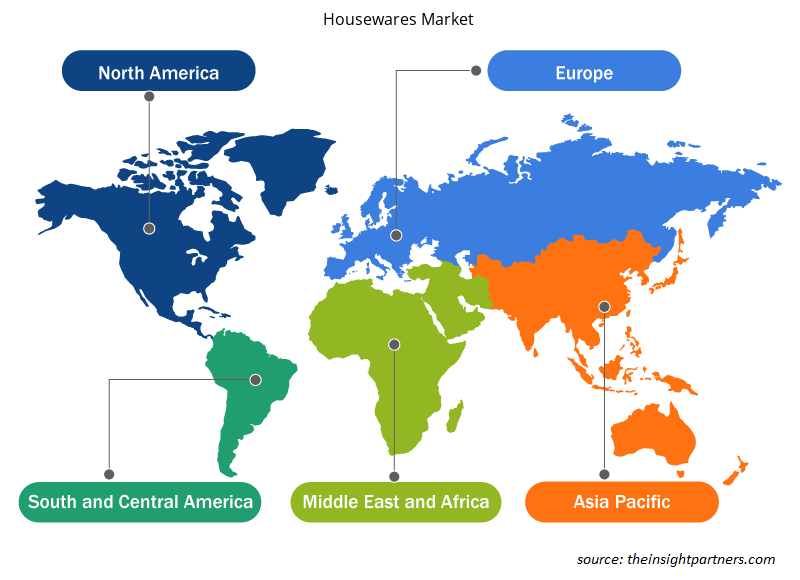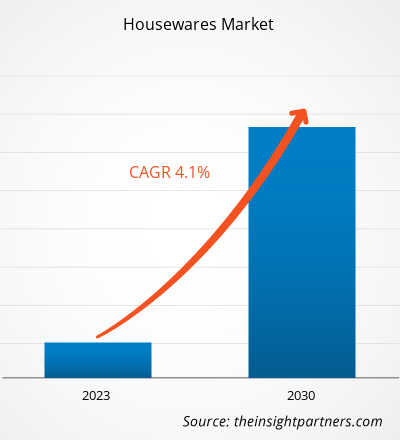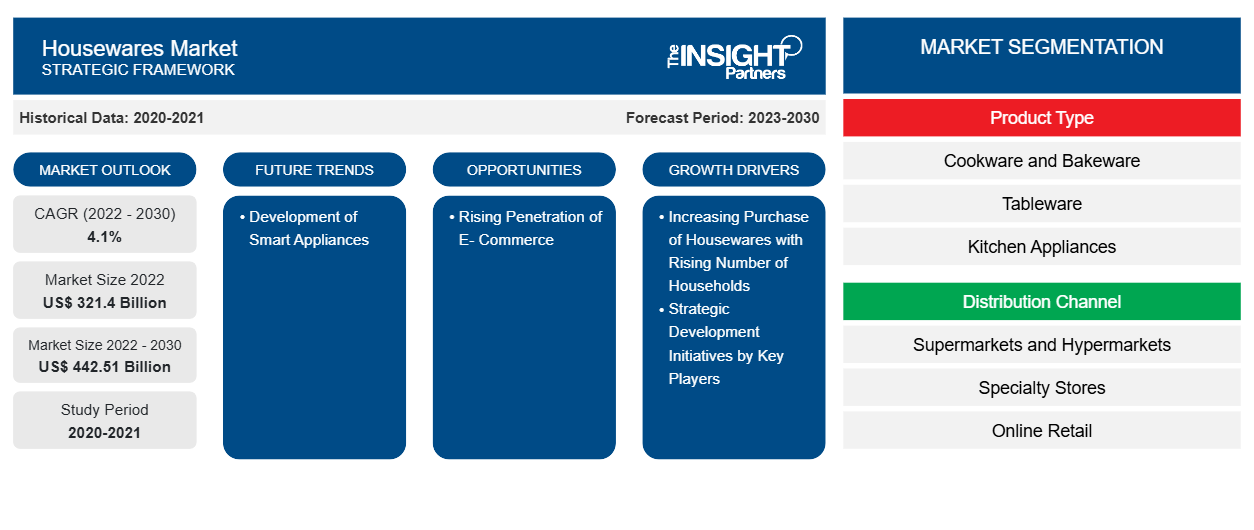[Rapport de recherche] La taille du marché des articles ménagers était évaluée à 321,40 milliards de dollars américains en 2022 et devrait atteindre 442,51 milliards de dollars américains d'ici 2030 ; on estime qu'elle enregistrera un TCAC de 4,1 % de 2022 à 2030.
Informations sur le marché et point de vue des analystes :
Les articles ménagers sont des produits et des articles utilisés dans un ménage pour cuisiner, faire des pâtisseries et organiser la maison, entre autres. Le marché des articles ménagers connaît une croissance constante en raison de facteurs tels que l'évolution des modes de vie et l'augmentation du temps passé à la maison, qui ont déclenché une demande d'articles ménagers fonctionnels et esthétiques. Pendant la pandémie de COVID-19, les gens ont passé plus de temps à la maison et ont investi dans l'amélioration de leur espace de vie. De plus, l'essor du commerce électronique et des plateformes d'achat en ligne a permis aux consommateurs d'accéder et d'acheter plus facilement une large gamme de produits ménagers depuis leur domicile. Ces facteurs, associés aux conceptions innovantes et aux options durables proposées par les entreprises d'articles ménagers, favorisent l'expansion du marché des articles ménagers.
Moteurs de croissance et défis :
Les changements dynamiques dans les modes de vie et l'augmentation du nombre de familles à double revenu ont entraîné une hausse des revenus disponibles et une amélioration du niveau de vie des ménages. Avec l'augmentation des revenus disponibles, les consommateurs dépensent des sommes importantes en articles ménagers et autres appareils permettant de vivre confortablement. Ils sont souvent disposés à acheter de nouveaux produits en raison de leurs styles uniques, qui font appel à leur individualité, ce qui entraîne une fréquence d'achat plus élevée. De plus, un nombre croissant de ménages composés d'une seule personne déclenche le besoin de modifications du logement, ce qui stimule la demande d'articles ménagers tels que des appareils de cuisine, des ustensiles de cuisine, des ustensiles de pâtisserie, de la vaisselle et des articles de salle de bain essentiels.
En outre, l'augmentation de l'urbanisation a renforcé la demande d'unités résidentielles et, en fin de compte, de produits ménagers. Selon le Bureau du recensement des États-Unis et le ministère américain du Logement et du Développement urbain, les États-Unis ont achevé la construction d'environ 1,3 million de logements en 2021, tandis que la construction d'environ 1,7 million de logements était en cours. De même, l'urbanisation croissante dans les pays européens a créé une énorme demande de logements résidentiels. Selon la Commission européenne, les permis de construire résidentiels ont augmenté de 42,3 % entre 2015 et 2021 dans l'Union européenne. En 2021, la France, l'Allemagne et la Pologne ont été les pays où le nombre de constructions résidentielles a le plus augmenté en Europe. Ainsi, la construction croissante de logements dans divers pays stimule encore davantage la demande d'articles ménagers. Ainsi, l'augmentation des achats d'articles ménagers ainsi que le nombre croissant de ménages propulsent la croissance du marché des articles ménagers.
Cependant, le marché des articles ménagers est très fragmenté et désorganisé en raison de nombreuses petites entreprises privées et vendeurs ambulants inexploités opérant dans les pays en développement. Selon un article publié dans Business Standards, en 2020, 80 % du marché des ustensiles de cuisine n'était pas organisé en Inde. Les petites entreprises locales utilisent des matières premières de mauvaise qualité pour fabriquer des articles ménagers tels que des ustensiles de cuisine, des ustensiles de pâtisserie, des accessoires de salle de bain et de la vaisselle. L'utilisation de matières premières de mauvaise qualité donne lieu à des produits finis de mauvaise qualité qui sont susceptibles d'être endommagés. De plus, les fabricants proposent ces produits à bas prix ; par conséquent, la majorité des consommateurs achètent ces produits en raison de leur prix abordable et de leur disponibilité facile. Ce facteur entraîne une diminution de la clientèle des principaux fabricants d'articles ménagers.
En outre, le plus souvent, les fabricants locaux du marché non organisé des articles ménagers ne respectent pas les normes réglementaires, ce qui peut poser des problèmes de qualité et nuire à la perception des consommateurs à l'égard des produits ménagers. En outre, la disponibilité de produits contrefaits peut nuire à l'image de marque des principaux acteurs. Ainsi, le manque d'uniformité dans les opérations et les réglementations freine la croissance du marché des articles ménagers.
Personnalisez ce rapport en fonction de vos besoins
Vous bénéficierez d'une personnalisation gratuite de n'importe quel rapport, y compris de certaines parties de ce rapport, d'une analyse au niveau des pays, d'un pack de données Excel, ainsi que de superbes offres et réductions pour les start-ups et les universités.
-
Obtenez les principales tendances clés du marché de ce rapport.Cet échantillon GRATUIT comprendra une analyse de données, allant des tendances du marché aux estimations et prévisions.
Segmentation et portée du rapport :
Le marché mondial des articles ménagers est segmenté en fonction du type de produit, du canal de distribution et de la géographie. En fonction du type de produit, le marché est classé en ustensiles de cuisine et de pâtisserie, vaisselle, appareils de cuisine, articles de salle de bain essentiels et autres. Par canal de distribution, le marché est classé en supermarchés et hypermarchés, magasins spécialisés, vente au détail en ligne et autres. Par géographie, le marché mondial des articles ménagers est largement segmenté en Amérique du Nord, Europe, Asie-Pacifique, Moyen-Orient et Afrique, et Amérique du Sud et Amérique centrale.
Analyse segmentaire :
En fonction du type de produit, le marché des articles ménagers est classé en ustensiles de cuisine et de pâtisserie, vaisselle, appareils de cuisine, articles de salle de bain essentiels et autres. Le segment des articles de table devrait enregistrer le TCAC le plus élevé au cours de la période 2022-2030. Le segment des articles de table comprend des produits tels que la vaisselle, les couverts, la verrerie et les ustensiles de service. L'augmentation de la demande d'articles de table sur le marché des articles ménagers peut être attribuée à la transformation des habitudes alimentaires pendant la pandémie de COVID-19. Comme de plus en plus de personnes dînent à la maison, les gens ont commencé à se concentrer sur la vaisselle esthétique et fonctionnelle, car elle améliore les expériences culinaires à domicile. Des repas quotidiens aux rassemblements spéciaux, les consommateurs recherchent des ensembles de vaisselle qui rehaussent leur expérience culinaire. En outre, l'appréciation croissante des designs uniques et artisanaux joue un rôle important dans la stimulation de la demande de vaisselle. Les consommateurs sont de plus en plus attirés par les pièces de vaisselle artisanales et d'inspiration artistique qui apportent une touche d'individualité et de personnalité à leurs repas. Ainsi, l'évolution vers des choix de vaisselle plus personnalisés et visuellement frappants a contribué à la progression du marché des articles ménagers pour le segment des arts de la table. Vivo - Villeroy & Boch Group, Corelle, Pyrex, Luminarc et Schott Zwiesel sont quelques-uns des principaux acteurs opérant sur le marché des arts de la table.
Analyse régionale :
Le marché des articles ménagers est segmenté en cinq régions clés : l'Amérique du Nord, l'Europe, l'Asie-Pacifique, l'Amérique du Sud et l'Amérique centrale, ainsi que le Moyen-Orient et l'Afrique. L'Asie-Pacifique a dominé le marché mondial des articles ménagers en 2022, le marché de cette région étant évalué à 120,63 milliards de dollars américains cette année-là. L'Europe est le deuxième contributeur majeur, détenant plus de 23 % des parts du marché mondial. L'Asie-Pacifique devrait enregistrer un TCAC considérable de plus de 5 % au cours de la période 2022-2030. L'urbanisation croissante et le revenu disponible de la population de la classe moyenne sont un facteur primordial qui stimule la demande d'articles ménagers modernes et pratiques, notamment d'appareils de cuisine avancés et de vaisselle élégante.
Aperçu régional du marché des articles ménagers
Les tendances et facteurs régionaux influençant le marché des articles ménagers tout au long de la période de prévision ont été expliqués en détail par les analystes d'Insight Partners. Cette section traite également des segments et de la géographie du marché des articles ménagers en Amérique du Nord, en Europe, en Asie-Pacifique, au Moyen-Orient et en Afrique, ainsi qu'en Amérique du Sud et en Amérique centrale.

- Obtenez les données régionales spécifiques au marché des articles ménagers
Portée du rapport sur le marché des articles ménagers
| Attribut de rapport | Détails |
|---|---|
| Taille du marché en 2022 | 321,4 milliards de dollars américains |
| Taille du marché d'ici 2030 | 442,51 milliards de dollars américains |
| Taux de croissance annuel moyen mondial (2022-2030) | 4,1% |
| Données historiques | 2020-2021 |
| Période de prévision | 2023-2030 |
| Segments couverts |
Par type de produit
|
| Régions et pays couverts |
Amérique du Nord
|
| Leaders du marché et profils d'entreprises clés |
|
Densité des acteurs du marché : comprendre son impact sur la dynamique des entreprises
Le marché des articles ménagers connaît une croissance rapide, tirée par la demande croissante des utilisateurs finaux en raison de facteurs tels que l'évolution des préférences des consommateurs, les avancées technologiques et une plus grande sensibilisation aux avantages du produit. À mesure que la demande augmente, les entreprises élargissent leurs offres, innovent pour répondre aux besoins des consommateurs et capitalisent sur les tendances émergentes, ce qui alimente davantage la croissance du marché.
La densité des acteurs du marché fait référence à la répartition des entreprises ou des sociétés opérant sur un marché ou un secteur particulier. Elle indique le nombre de concurrents (acteurs du marché) présents sur un marché donné par rapport à sa taille ou à sa valeur marchande totale.
Les principales entreprises opérant sur le marché des articles ménagers sont :
- Maison Bradshaw Inc.
- La société Denby Pottery Co Ltd
- HF Coors Co Inc
- Inter IKEA Holding BV
- Hutzler Manufacturing Co Inc
Avis de non-responsabilité : les sociétés répertoriées ci-dessus ne sont pas classées dans un ordre particulier.

- Obtenez un aperçu des principaux acteurs du marché des articles ménagers
Impact de la pandémie de COVID-19 :
La pandémie de COVID-19 a initialement entravé le marché mondial des articles ménagers en raison de la fermeture des unités de fabrication, de la pénurie de main-d'œuvre, de la perturbation des chaînes d'approvisionnement et de l'instabilité financière. La perturbation des opérations dans diverses industries en raison du ralentissement économique causé par l'épidémie de COVID-19 a restreint l'approvisionnement en articles ménagers. De plus, plusieurs magasins ont été fermés, ce qui a limité les ventes d'articles ménagers. Néanmoins, les entreprises ont commencé à gagner du terrain lorsque les restrictions précédemment imposées ont été révoquées dans divers pays en 2021. De plus, la mise en œuvre des campagnes de vaccination contre la COVID-19 par les gouvernements de différents pays a amélioré la situation, entraînant une augmentation des activités commerciales dans le monde entier. Plusieurs marchés, dont le marché des articles ménagers, ont enregistré une croissance après l'assouplissement des mesures de confinement et des restrictions de mouvement.
Paysage concurrentiel et entreprises clés :
Bradshaw Home Inc, Denby Pottery, HF Coors Co Inc, Inter Ikea Holding Bv, Hutzler Manufacturing Co Inc, TTK Prestige Ltd, Newell Brands Inc, BSH Hausgerate GmbH, Kohler Co et Haier US Appliance Solutions Inc font partie des principaux acteurs opérant sur le marché mondial des articles ménagers.
- Analyse historique (2 ans), année de base, prévision (7 ans) avec TCAC
- Analyse PEST et SWOT
- Taille du marché Valeur / Volume - Mondial, Régional, Pays
- Industrie et paysage concurrentiel
- Ensemble de données Excel
Rapports récents
Témoignages
Raison d'acheter
- Prise de décision éclairée
- Compréhension de la dynamique du marché
- Analyse concurrentielle
- Connaissances clients
- Prévisions de marché
- Atténuation des risques
- Planification stratégique
- Justification des investissements
- Identification des marchés émergents
- Amélioration des stratégies marketing
- Amélioration de l'efficacité opérationnelle
- Alignement sur les tendances réglementaires























 Obtenez un échantillon gratuit pour - Marché des articles ménagers
Obtenez un échantillon gratuit pour - Marché des articles ménagers